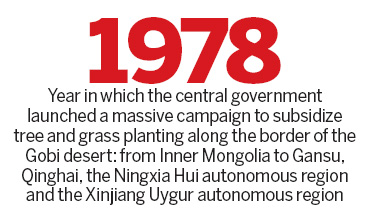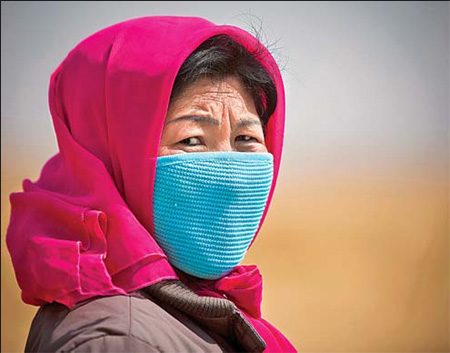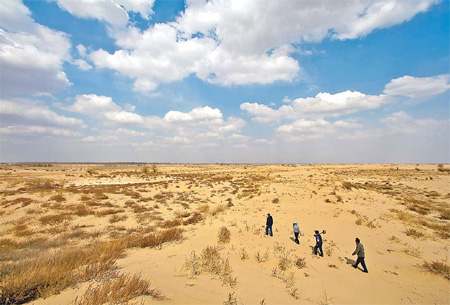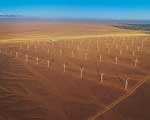Building last line of defense against desert
By Daniel Chinoy (China Daily)
2010-05-25 07:52
|
|
|
|
Related Video: Building last line of defense against desert
Villagers turn to trees as the last hope in holding back spreading desert. Daniel Chinoy reports from Inner Mongolia.
For generations, residents in Gaotou have earned their living by herding livestock on Inner Mongolia's sweeping grasslands. Today, all that stands between rolling sand dunes and this small collection of brick houses, dirt roads and dusty fields are a few rows of poplar saplings that villagers like Yirugeletu (who, like many Mongolians, uses only one name) are working desperately to expand.
A tough, hard-drinking man with a thin moustache, Yirugeletu says the trees are Gaotou's last line of defense against the desert, helping block the wind and anchor the soil.
|
|
"If the desert keeps expanding, we won't be able to protect our fields," explained the 32-year-old farmer. "If we don't plant trees, the wind will blow the desert in."
That would make it impossible to grow the soybeans and maize that so many villagers in the autonomous region rely on, he said.
Gaotou's problems are hardly unique. According to a 2004 government survey - the most recent available - about 28 percent of China is classified as desert. That is about 2.6 million square kilometers, more than seven times the size of Germany.
Much of that desert is new, created only in the last two or three decades, as China's rapid development sapped the region of its trees, grass and water.
The consequences have been severe. The advancing desert has forced farmers to work harder in the fields and spend more money to grow the crops they need to survive, said Liu Zhimin, a professor at the Chinese Academy of Sciences' institute for applied ecology in Shenyang, capital of Liaoning province. Millions of people have had to flee their land, with many ending up as migrant workers in major cities.
"Desertification increases poverty," said Liu. "It makes the land resources needed for raising animals and farming scarce, and consequently lowers farmers' incomes."
The Development Research Center of the State Council estimated in 2008 that desertification costs China about 54 billion yuan ($8 billion) in lost economic activity each year - a figure that some experts believe actually understates the problem.
Desertification also contributes to the enormous sandstorms that engulf parts of China every spring. The State Forestry Administration counted 12 this year across North China.
In response, many towns across China have, like Gaotou, turned to tree planting to protect their land. In 1978, the central government launched a massive campaign to subsidize tree and grass planting along the border of the Gobi desert, from Inner Mongolia to Gansu province, Qinghai province, the Ningxia Hui autonomous region and the Xinjiang Uygur autonomous region.
Since 2000, the government has increased its investment in tree planting and expanded efforts to emphasize conservation, reduce over-grazing and over-cultivation, and encourage more careful use of water, according to Liu Tuo, director general of the National Bureau to Combat Desertification under the State Forestry Administration.
As a result, over the last decade, an estimated 10,000 square kilometers of grass and trees have been planted annually, he said.
Though these efforts have all helped to significantly slow the desert's growth, experts say that it remains unclear whether the now enormous belts of trees along the edge of the desert - dubbed the "great green wall" - will be able to stop the desert from growing in the long term.
Getting it right
When done correctly, scientists agree there are clear benefits to planting trees. One of the non-governmental organizations (NGOs) actively promoting tree planting is Shanghai-based Roots and Shoots, which manages a program called the Million Tree Project in Gaotou and several other small villages nearby.

"The planting of trees cool the ground in summer, help channel what water there is back into the ground, create habitats for birds to land and drop seeds, provide some cover for crops from the high heat in summer and stabilize the dunes," said Robin Rose, a professor at Oregon State University and the program's science adviser.
"We started the project with the concept that, if we come out here and work with the local farmers in this region, which lies right on the cusp of desertified land, then we can help stop the desert from expanding and help farmers reclaim the land that's been taken over by the desert," added project coordinator Alex Pulichino.
One of the most basic challenges, though, is choosing what to plant and where, something that has frequently been an issue in China's tree planting efforts.
Daotian, a village of about 300 people two hours south of Gaotou, is near a reservoir and already has significantly more trees. However, most of the trees here were planted 20 years ago during a previous campaign and little thought was given to selecting the right species or location. Consequently, despite the more hospitable land, many of them are dying or have grown poorly because they need more water than is available.
To correct this, the county forestry bureau recently decided to cut down most of the trees and plant new ones. As part of this project, the Roots and Shoots volunteers planted about 500 poplars in Daotian this spring.
The poplar is native to Inner Mongolia and does not require much water to survive, making it particularly appropriate for the arid climate in places like Gaotou and Diaotian, said Sun Litao, forestry manager for Roots and Shoots.
"Initially, they planted the wrong kind of tree and it didn't grow well. It didn't fit the local ecosystem," he said.
Daotian's experience is not uncommon, experts say, and the planting of trees in places where they are unlikely to survive or will grow poorly remains a major problem. Often it is exacerbated by farmers who plant as many trees as possible to get the subsidies the government offers to support afforestation projects, regardless of whether they help fight the desert or not.

"China's implementation of large-scale afforestation throughout arid and semi-arid regions has ignored differences in topography, climate and hydrology, all of which can affect tree survival," wrote Cao Shixiong, a professor at China Agriculture University, in a 2008 article for the journal Environmental Science and Technology.
For its part, the State Forestry Administration acknowledges that this remains an issue, although Liu Tuo contends that it happens much less frequently than it used to. "We want to make sure the vegetation types are appropriate for where they are planted," he said.
Farmers often also do not know how to take care of the trees after they have been planted - something that goes beyond simply watering and pruning them properly.
The trees play a complex role in the ecosystem, and understanding when to plant and what to plant near them is a key part of what makes planting trees an effective tool. Forestry manager Sun said he spends most of the year in Inner Mongolia to provide this kind of training to the farmers, which experts say is crucial to fighting desertification.
"We need to do capacity building in a very integrated way, with land management and integrated ecosystem management," said Andrea De Angelis, the United Nations Development Program's advisor on climate in Beijing. "We should ask people to plant trees and, in parallel, endow them with the skills to manage the trees."
Too much to bear
However, even planting the right trees in the right places in the right way can only do so much, especially given how difficult it is to control the complicated social, economic and environmental forces that can turn grassland to desert in just a matter of years.
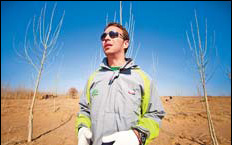
 |
Perhaps the most fundamental issue is population. With 1.3 billion people to feed, China's farmers and herders have a strong incentive to over-plant and over-graze. Today, an estimated 90 percent of China's grassland is considered degraded.
"It's very easy to breed too many animals because of incentives from the market, but clearing too much land for farming and overgrazing can easily cause the land to degrade and eventually become desert," said Li Wenjun, a professor of environmental science at Peking University.
In the wake of de-collectivization in 1978, villagers in Gaotou began breeding more livestock to sell to a rapidly growing market than they ever had before. At one point, most households, including Yirugeletu's, were each tending to flocks of about 300 sheep and 80 cows.
The market brought other pressures, too. With the end of the commune system, families were suddenly reliant on their herds for new expenses that had previously been covered by the government, including medical bills, school fees, water, fertilizer and feed.
"The cost of living increased for the herders, so they raised more livestock," said Hu Jingping, director of the Inner Mongolia Grassland Area Cooperation and Sustainable Development Research Center. "But the grasslands didn't get any bigger."
As a result, more livestock was grazing on smaller plots of grass than ever before, and sometime between 10 and 15 years ago, Gaotou simply ran out of grass. Without any cover, most of the topsoil was quickly blown away by the wind, leaving nothing but sand in its place.
"The sheep ate all the grass. When it was gone, the desert came," said Yirugeletu.
Greater wealth, increased consumption of everything from plastics to washing machines, and rapid urbanization, including the settling down of once-nomadic populations in the late 1970s and early 1980s, have all exacerbated the problem by intensifying water use and lowering regional water tables.
"People's standard of living has increased, and with that increase their ability to affect nature has increased, too," said Hu Yuegao, director of the China Center for Management and Prevention of Desertification and a professor at China Agricultural University.
Global warming is also an important factor. "Once we have more CO2 (carbon dioxide) in the atmosphere globally, the surface temperature is going to increase. In certain areas this can cause increased evaporation, which can exacerbate drought and desertification," said De Angelis.
In some cases higher temperatures also cause ice and glaciers to melt more quickly, leading to flash floods. These can further erode the land around the rivers and streams that provide places like Inner Mongolia with what limited water they have, he added.
"China has not yet found a comprehensive answer to desertification," said Hu Yuegao. "This is a problem that all of society created and will require all of society to fix, including government, businesses and ordinary people."
In the meantime, for many the only option is to continue to put their faith in trees.
Wang Hua, one of Daotian's wealthier farmers, has spent 20,000 yuan - a substantial portion of his savings - on new saplings to plant around his fields in addition to the trees donated by Roots and Shoots.
"These trees will protect us from the wind and the sand," said the 52-year-old as he gestured hopefully at rows of recently planted poplars along his fields. "Because of them, I'm not worried about the desert."
|
|

